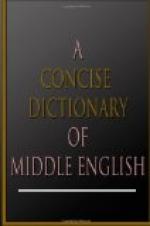69. Tatian: Evangelienbuch, ed. Sievers, 1872.
70. TG: Trench, Select Glossary, 1879.
71. Trevisa: version of Higden, Rolls’ Series (41).
72. Voc.: Wright’s Vocabularies, ed. WA1/4lcker, 1884.
73. VP: Vespasian Psalter, as printed in OET., see 45.
74. Vulg.: the Vulgate Version of the Bible.
75. W: Wycliffe, New Testament (Purvey’s revision), ed. Skeat, 1879. CP.
76. W2: Wycliffe, Job, Psalms, &c. (revised by Hereford and Purvey), ed. Skeat, 1881. CP.
77. WA: Wars of Alexander, ed. Skeat, 1887, EETS (Extra Series xlvii).
78. Weigand: deutsches WArterbuch, 1878.
79. Windisch: Glossary added to Old Irish Texts, 1882.
80. WW: Wright, The Bible Word-Book, 1884.
81. ZRP: Zeitschrift fA1/4r romanische Philologie, ed. GrAber.
ABBREVIATIONS (LANGUAGES),
WITH REFERENCES TO AUTHORITIES.
AF: Anglo-French, see 64.
AS: Anglo-Saxon, see 10, 31, 45, 62.
Church Lat.: Ecclesiastical Latin, see 24, 74.
Goth.: Gothic, see 23, 65.
Gr.: Greek, see 9, 19, 27.
Icel.: Icelandic, see 20.
It.: Italian, see 28.
Lat.: Latin.
Late Lat.: Post-classical Latin, of Latin origin.
see 24. 72. 74.
Low Lat.: Latin derived from the later European
languages, see 1, 14, 24,
51, 58.
ME.: Middle English.
North.E.: Northern English, see 4, 36.
OF.: Old French, see 3, 6, 17, 18, 22, 24, 30,
48, 54.
OHG.: Old High German, see 37, 46, 69, 78.
OIr.: Old Irish, see 19, 79.
OMerc.: Old Mercian, see 2(Rushworth version),
45, 73.
ONorth.: Old Northumbrian, see 2.
OS.: Old Saxon, see 35.
OTeut.: Old Teutonic (as restored by scholars),
see 27, 43.
Sp.: Spanish, see 41.
SYMBOLS.
In the etymological part three stops are used as symbols in connexion with the cognate forms cited, namely the comma, the semi-colon, and the colon. The comma is used to connect various spellings of a word, as well as parallel forms cited from nearly connected languages; for instance, s.v. daunger, the OF. forms are so connected. The semi-colon between two forms denotes that the two forms are phonetically equivalent, and that the preceding one is directly derived from, and is historically connected with the one following this symbol; for instance, s.v. bugle, the OF. bugle is the phonetic equivalent of the Lat. buculum, and is immediately derived therefrom. The colon between two forms denotes that the two forms are phonetically equivalent, and that the form following this symbol is an earlier, more primitive form than the one preceding, without an immediate interborrowing between the languages being asserted; for instance, s.v. demen, the Goth, dA cubedmjan is an older form than the AS. dA(C)man, but dA(C)man is not borrowed from the Gothic. The abbreviation ‘cp.’ introduces other cognate forms, and has the same value as the symbol + in Skeat’s Dictionaries.




